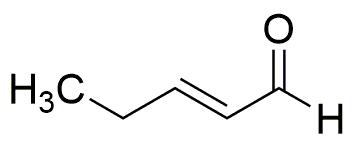trans-2-Pentenal is widely utilized in research focused on:
- Flavor and Fragrance Industry: This compound is commonly used as a flavoring agent in food products and as a fragrance component in perfumes due to its pleasant aroma. Its unique scent profile enhances consumer products, making them more appealing.
- Synthesis of Fine Chemicals: It serves as an important intermediate in the synthesis of various fine chemicals, including pharmaceuticals and agrochemicals. Researchers leverage its reactivity to create complex molecules efficiently.
- Analytical Chemistry: In laboratories, trans-2-Pentenal is utilized as a standard in gas chromatography. Its distinct properties allow for accurate calibration and analysis of other volatile compounds, ensuring reliable results in research.
- Biochemical Research: This compound is studied for its potential biological activities, including antimicrobial properties. Researchers explore its effects on various microorganisms, contributing to the development of new antimicrobial agents.
- Polymer Chemistry: It is used in the production of polymers and resins, where its unsaturated structure allows for cross-linking reactions. This application is crucial in developing materials with specific mechanical properties for various industrial uses.
General Information
Properties
Safety and Regulations
Applications
trans-2-Pentenal is widely utilized in research focused on:
- Flavor and Fragrance Industry: This compound is commonly used as a flavoring agent in food products and as a fragrance component in perfumes due to its pleasant aroma. Its unique scent profile enhances consumer products, making them more appealing.
- Synthesis of Fine Chemicals: It serves as an important intermediate in the synthesis of various fine chemicals, including pharmaceuticals and agrochemicals. Researchers leverage its reactivity to create complex molecules efficiently.
- Analytical Chemistry: In laboratories, trans-2-Pentenal is utilized as a standard in gas chromatography. Its distinct properties allow for accurate calibration and analysis of other volatile compounds, ensuring reliable results in research.
- Biochemical Research: This compound is studied for its potential biological activities, including antimicrobial properties. Researchers explore its effects on various microorganisms, contributing to the development of new antimicrobial agents.
- Polymer Chemistry: It is used in the production of polymers and resins, where its unsaturated structure allows for cross-linking reactions. This application is crucial in developing materials with specific mechanical properties for various industrial uses.
Documents
Safety Data Sheets (SDS)
The SDS provides comprehensive safety information on handling, storage, and disposal of the product.
Product Specification (PS)
The PS provides a comprehensive breakdown of the product’s properties, including chemical composition, physical state, purity, and storage requirements. It also details acceptable quality ranges and the product's intended applications.
Certificates of Analysis (COA)
Search for Certificates of Analysis (COA) by entering the products Lot Number. Lot and Batch Numbers can be found on a product’s label following the words ‘Lot’ or ‘Batch’.
*Catalog Number
*Lot Number
Certificates Of Origin (COO)
This COO confirms the country where the product was manufactured, and also details the materials and components used in it and whether it is derived from natural, synthetic, or other specific sources. This certificate may be required for customs, trade, and regulatory compliance.
*Catalog Number
*Lot Number
Safety Data Sheets (SDS)
The SDS provides comprehensive safety information on handling, storage, and disposal of the product.
DownloadProduct Specification (PS)
The PS provides a comprehensive breakdown of the product’s properties, including chemical composition, physical state, purity, and storage requirements. It also details acceptable quality ranges and the product's intended applications.
DownloadCertificates of Analysis (COA)
Search for Certificates of Analysis (COA) by entering the products Lot Number. Lot and Batch Numbers can be found on a product’s label following the words ‘Lot’ or ‘Batch’.
*Catalog Number
*Lot Number
Certificates Of Origin (COO)
This COO confirms the country where the product was manufactured, and also details the materials and components used in it and whether it is derived from natural, synthetic, or other specific sources. This certificate may be required for customs, trade, and regulatory compliance.

